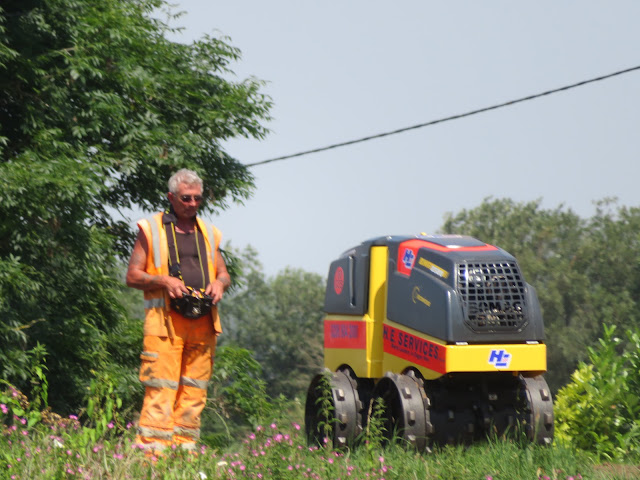I had called the lock keeper at Salter's Lode and he said that the tides on Wednesday would mean they would start passing boats through about 1100. We therefore set out soon after 0900. However Helen had time to pop over the road to Brian Tweed;s the Butchers to buy some haselet as he makes his own. They are also a key holder for the water point on the Church Bridge moorings. We didn't take any but we did leave a donation in the tin on the counter to assist in their efforts to keep the water way open.
As we passed through Outwell I saw this post, or is it a tower mill. No longer with sails, and probably no machinery either. I am surprised that there are so few of these buildings left as they make quirky and interesting houses, and so would have survived.
This Outwell Boat station and is where the Wisbech Canal left Well Creek. It is also where the Wisbech to Upwell Tramway light railway came into the village. It was built in 1883 and closed to passengers in 1927 and to freight in 1966.
This bridge at Nordelph is one of the lowest bridges on the Well Creek. I think the bridge by the Aqueduct over the Middle Level Main Drain is slightly lower.
Well Creek is very sallow, and narrow and there seem to be plenty of boats moored along it too. This means that my estimate for arriving on time at 1100 was slightly out and we arrived 10 minutes late. There was a boat on the landing that had broken down. I managed to get the bow in and find the lock keeper to tell him of our arrival. The tidal river was just making a level with the Creek so we were told to enter. You can see that by the time we are in the lock the water level in the river is about 4 inches above.
The gates were closed behind us, and lifted ahead. As we passed under mud splattered the boat. No time to worry about that as we were off. We weren't told that a boat was on the way from Denver. Helen's was surprised that there were several folk casually sat on the bow of the wide beam and nobody had a lifejacket/floation device on at all.
We were so early on the tide that the 'island' off the lock was still visible. I had noticed that there wasn't much water close to the slight bend before it, but I was more worried about getting carried past and missing the narrow channel altogether. Consequently we touched the mud on the port side and rubbed along it until we got to the pontoons, and into the lock.
We were soon through and onto the River Great Ouse. It was really nice to be on wide deep water and the speed was consequently increased for the same revs. There were several boats underway and this couple were just about to turn down the River Wissey.
Just a little further on there was a digger working on the verge of a road. I then noticed this little articulated vehicle that was obviously remote controlled by the bloke in the picture. I thought it was a small roller from a distance but obviously with the studded wheels that can't be its function. I have looked on line and don't seem to be able to find anything similar. I'm obviously not asking the right questions of Google.
Although we have seen the cathedral before, and probably even taken this same picture, but it is still incredible to me that they could build like this, and on this scale so many years ago. No remote controlled, articulated assistance here.
We luckily found a mooring down by the Cutter Inn and once settled walked up through the Meadow to the Cathedral and the Ely Porta. Next to it was this 14th Century ecclesiastical barn. It was used to store wheat, malt, salted meat, fish and other goods to sustain the establishment. Now it is used by the King's School, as most of the old Bishop's buildings seem to be nowadays, as the school dining hall. We were heading up the town to find a drink. Whilst underway we didn't really feel the heat.Once we stopped it felt that we had been in a tumble drier, windblown and heated. We tried a couple of pubs as well as buying some cards in the Cathedral.
I saw this on the side of a building called Militia House on Silver Street in Ely. Obviously WD stands for War Department along with the broadheaded arrow. It is interesting that it is on a building called Militia House too. The arrow is used as a bench mark for spot heights but it is unlikely to be the first one ever. Anybody able to enlighten me?
I noticed these chimneys off High Street. I plain old fashioned chimney pot costs about £80 just to put plants in. The cost to construct these beauties must have been immense. In the 'old days' labour was cheap I suppose. What a statement they make though. If I had done this work I would be bringing my grand children to show them.












2 comments:
Here’s that little machine on the website of the hire firm — complete with data sheet,
https://www.heservices.co.uk/rollers/
Hi Adam, Thanks for that information. I was obviously looking at the wrong company!! I had never heard of a trench roller before, never mind see one. I don't really see how it is a saving as one bloke drives it whether sitting on it or driving remotely! Must be a bit safer down a hole though.
Currently we are sat at Brandon Lock, as far east as you can get on the system.
Hope to see you soon. Tony and Helen.
Post a Comment